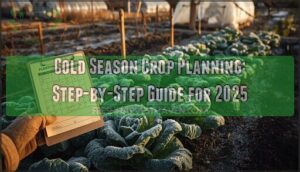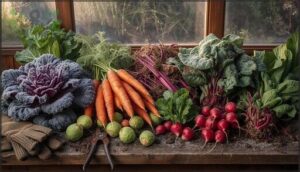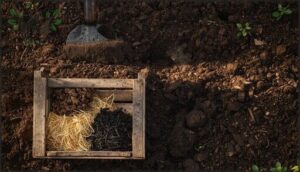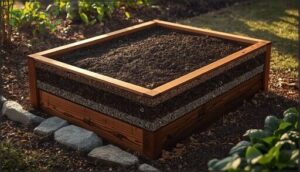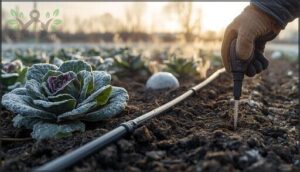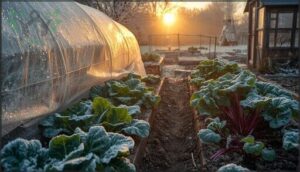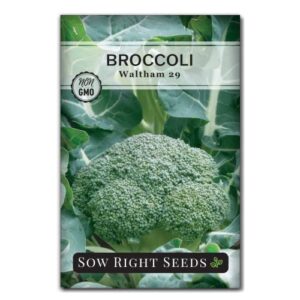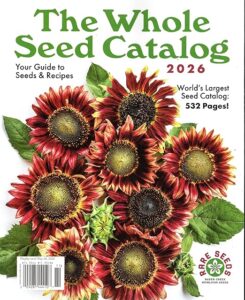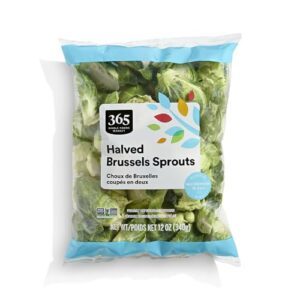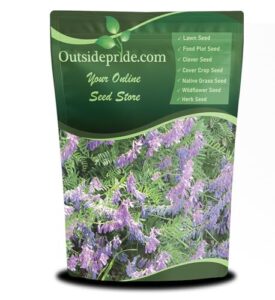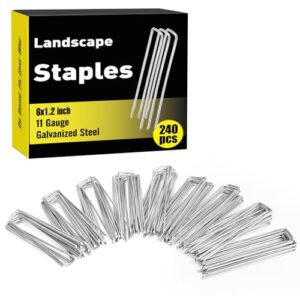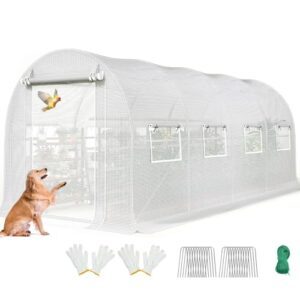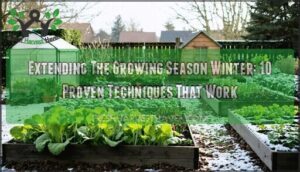This site is supported by our readers. We may earn a commission, at no cost to you, if you purchase through links.
Last winter, a farmer in Zone 6 watched his neighbor harvest fresh spinach and kale through January while his own beds sat frozen and barren. The difference wasn’t luck or better soil—it was timing. Cold season crop planning separates gardeners who eat fresh greens in February from those staring at empty rows, and the margin between success and failure often comes down to decisions made months earlier.
Your region’s first frost date, soil temperature at planting, and variety selection create a cascade of outcomes that determine whether you’ll harvest or wait until spring. The good news: you can master this process by following a systematic approach that accounts for your microclimate, matches crops to your growing window, and builds in protection strategies that keep plants thriving when temperatures drop.
Table Of Contents
- Key Takeaways
- Step-by-Step Cold Season Crop Planning
- Selecting Cold-Hardy Vegetables and Varieties
- Preparing and Managing Your Winter Garden Beds
- Extending The Growing Season and Maximizing Yields
- Top 10 Essential Products for Cold Season Crop Planning
- 1. Usa Plant Hardiness Zone Map Poster
- 2. Winter Density Lettuce Seeds
- 3. Non Gmo Heirloom Broccoli Seeds
- 4. Heirloom Seed Gardening Catalog Guide
- 5. Fresh Halved Brussels Sprouts Bag
- 6. Andersons HumiChar Organic Soil Amendment
- 7. Hairy Vetch Cover Crop Seeds
- 8. Mini Wooden Greenhouse Cold Frame
- 9. Galvanized Landscape Fabric Staples Pack
- 10. Premium Outdoor Greenhouse Kit
- Frequently Asked Questions (FAQs)
- Conclusion
Key Takeaways
- Your frost date and zone matter less than your microclimate—south-facing slopes and wind-protected corners can shift temperatures by 10°F, turning marginal crops into reliable producers when you map these pockets before planting.
- Count backward from first frost using days-to-maturity plus two weeks for cold-slowed growth, then stagger sowings every 10–14 days so you’re harvesting fresh greens weekly instead of facing a single glut followed by empty beds.
- Layer your protection methods for compound benefits—mulch plus row covers can add 10°F of frost resistance, while cold frames create microclimates equivalent to moving 500 miles south, extending harvests by months.
- Fast-maturing varieties like 35-day spinach and 45-day tatsoi fit narrow windows before hard freezes arrive, and selecting “winter” or “frost-tolerant” on seed packets ensures plants accumulate sugars under stress to survive down to 15°F.
Step-by-Step Cold Season Crop Planning
Planning a successful cold-season garden starts with understanding your specific growing conditions and timing everything just right. You’ll need to evaluate several key factors before you put a single seed in the ground.
Let’s walk through the essential steps that’ll set you up for a productive winter harvest.
Assessing Your USDA Hardiness Zone
Pinpointing your USDA zone sets the foundation for successful winter vegetable garden planning. The 2023 map uses data from over 13,000 stations, giving you precise hardiness levels for selecting cold-hardy crops. Understanding the plant hardiness zones is essential for gardeners to make informed decisions.
- Visit the interactive USDA Plant Hardiness Zone Map online
- Enter your zip code to identify your zone and subzone
- Note your average minimum winter temperature range
- Cross-reference frost dates with local extension resources
Determining Your Garden Microclimate
Your USDA zone gives the big picture, but microclimates within your garden can shift conditions by a full zone—nearly 10°F warmer or colder. South-facing slopes warm earlier and extend your frost date, while low spots become frost pockets where cold air settles.
Your garden’s microclimates can shift temperatures by nearly 10°F, turning south-facing slopes into early-warming zones and low spots into frost pockets
Measure soil temperature near walls and windbreaks to identify where cold-hardy crops will thrive earliest, and map wind protection patterns that shelter tender seedlings from drying blasts.
Understanding local microclimates is essential for successful crop planning and garden management.
Choosing The Right Planting Dates
Once you’ve mapped your microclimate, count backward from your first fall frost date using each crop’s days to maturity—then add two extra weeks for slower cold-season growth.
Leafy greens sown 8 weeks before frost, root crops 10–12 weeks, guarantee plants mature before hard freezes arrive.
Check soil temperature too: spinach germinates at 40°F, lettuce needs 60°F for reliable stands.
Mapping Out Succession Planting Strategies
After locking in planting dates, sketch a succession planting strategy that staggers sowings every 10–14 days. This keeps your winter vegetable garden churning out cold-hardy crops like lettuce and spinach for weeks instead of a single glut harvest.
Here’s how to implement it:
- Start your first sowing when soil temperature hits the minimum for each cool season crop.
- Plant a second round two weeks later, repeating until frost dates close your window.
- Layer different maturity varieties—early, mid, late—for extended harvests from one seeding day.
- Track garden layout and microclimates so faster-warming beds host your earliest succession rounds.
Staggered succession planting strategies also smooth out pest pressure and let you fine-tune crop rotation without leaving bare soil exposed.
Planning Crop Rotations for Soil Health
Smart crop rotation transforms your soil from season to season. Rotate cool season crops—moving brassicas away from last year’s cabbage patch, for instance—to break pest cycles and balance nutrient draw.
Follow nitrogen-hungry greens with nitrogen-fixing legumes or cover cropping phases that rebuild organic matter and curb soil erosion.
This companion planting rhythm keeps your beds productive and your soil health climbing all winter.
Selecting Cold-Hardy Vegetables and Varieties
Choosing the right vegetables makes all the difference between a thriving winter garden and a disappointing one. You’ll want to focus on varieties specifically bred to handle cold temperatures and shorter daylight hours in your particular zone.
Let’s look at how to identify the best crops for your region, select varieties that can handle frost, and plan for continuous harvests throughout the cold season.
Identifying Cool-Season Crops Suited to Your Region
Your cool season crop selection hinges on aligning plant cold tolerance with your USDA zone’s minimum temperatures and growing window. Hardy crops like kale, spinach, and Brussels sprouts thrive in Zones 5–7, handling frosts near 28°F, while semi-hardy lettuce and beets suit milder Zones 8–9.
Match soil temperature needs—most cool season crops germinate around 40–45°F—to your regional planning calendar for successful climate adaptation.
Selecting Fast-Maturing and Frost-Tolerant Varieties
Your variety selection should target crops that mature before hard freezes arrive—think spinach ready in 35–45 days or turnips in 30–60. Look for “winter” or “frost-tolerant” in seed descriptions; these cold-hardy varieties accumulate sugars under stress, surviving temperatures down to 15°F.
Fast-maturing broccolini (50–70 days) and tatsoi (45 days) fit narrow windows, while kale and cabbage tolerate repeated subfreezing nights with proper mulch protection.
Planning for Multiple Harvests With Short-Season Crops
To keep your beds producing through winter’s chill, succession sowing is the backbone of a continuous harvest. Plant lettuce, spinach, or radishes every 7–14 days from late summer through early fall—this simple rhythm delivers fresh greens weekly.
Here’s how to optimize your cool-season crop selection:
- Sow fast-maturing greens (lettuce, arugula) every week for 20+ harvest windows
- Layer short-season crops like baby kale (25 days), then spinach (45 days)
- Backdate from first frost—count maturity days backward to time final sowings
- Rotate crop families between successions to support soil health and pest management
This succession planting approach, combined with frost management using row covers in microclimates, extends your season and keeps cold-hardy crops thriving into December.
Preparing and Managing Your Winter Garden Beds
Getting your garden beds ready for winter crops isn’t complicated, but it does require some thoughtful preparation to set your plants up for success. The right combination of soil care, structural improvements, and protective measures will keep your cold-hardy vegetables thriving even when temperatures drop.
Let’s walk through the essential steps to prepare and maintain productive winter beds that deliver fresh harvests all season long.
Soil Preparation and Organic Amendments
Before you plant a single seed, get your soil right—it’s the foundation for everything that follows. Test your soil every three to five years to nail down pH and nutrient levels, then work in two to five centimeters of finished compost across your beds.
Fall amendments like composted manure, biochar, or cover crops give months for breakdown before spring planting, building organic matter and improving water-holding capacity naturally. Always cover amended beds with mulch or plastic to guard against nutrient leaching during winter rain.
Pair biochar with compost or manure to stabilize nutrients and buffer pH swings. Leguminous cover crops like vetch or clover fix atmospheric nitrogen, cutting synthetic fertilizer needs.
| Amendment Type | Application Rate & Timing |
|---|---|
| Finished compost | 2.5–5 cm layer; late fall or early winter |
| Composted manure | Spread early winter; allows nutrient stabilization |
| Coffee-pulp biochar | 4 tons/hectare; boosts pH, carbon, nitrogen |
| Legume cover crops | Seed ~1 month before first hard frost |
| Compost–biochar blend | Mix before spreading; enhances microbial activity |
Installing Raised Beds for Improved Drainage
Waterlogged roots spell trouble for winter crops, but raised beds solve that fast. Build frames 12 to 24 inches deep and three to four feet wide—you’ll achieve faster spring warm-up, healthier soil microbes, and sturdy root systems that withstand heavy rain.
- Frame your beds with rot-resistant cedar, stone, or composite lumber
- Layer coarse gravel or wood chips at the base for internal drainage
- Amend fill soil with compost to balance moisture retention and aeration
- Grade the site gently so excess water flows away naturally
- Space beds to allow airflow and prevent compaction from foot traffic
Proper bed frame construction cuts waterlogging risks and sets the stage for steady cool season gardening success.
Using Mulch, Row Covers, and Cold Frames
Once you’ve secured good drainage, layer on extra defenses against the cold. Mulch, row covers, and cold frames work together to insulate soil, trap warmth, and shield cold-hardy crops from harsh weather.
Protection Method Comparison
| Method | Frost Protection | Light Transmission | Moisture Retention | Installation |
|---|---|---|---|---|
| Organic Mulch | +1–2°F soil buffer | 0% (opaque) | +14% soil moisture | Spread 2–4″ layer |
| Lightweight Row Covers | +2–4°F air temp | 85–90% | Moderate | Drape over hoops |
| Heavy Row Covers | +5–7°F air temp | 50–70% | High | Secure edges firmly |
| Glass Cold Frames | +10–15°F zone shift | 90% | Very high | Build or buy frame |
| Combined (Mulch + Cover) | +8–12°F total | 50–85% | Highest | Layer both methods |
Apply straw or shredded leaves around stems to buffer soil temperature swings by up to 1.9°C and cut water loss by 40%. Drape spunbonded polypropylene row covers over hoops for an extra 2–7°F of frost protection—heavier fabrics shield better but dim light slightly.
Position cold frames over beds to extend your winter vegetable garden by months, boosting yields 30–50% and survival rates up to 40%. Stack these frost protection methods for maximum resilience: mulch plus row covers can add 10°F of safeguarding, slashing crop losses by half and doubling harvest frequency all season long.
Winter Irrigation and Moisture Management
Your frost protection methods won’t succeed without smart winter irrigation strategies. Cold weather gardening demands a different rhythm—water every three to four weeks, soaking soil to six inches deep.
Drip irrigation systems deliver precision, cutting use by 60% while keeping foliage dry.
Check soil moisture monitoring weekly; moist ground before a freeze stores heat and boosts frost tolerance by buffering roots against cold injury.
Pest and Disease Prevention in Cold Weather
Healthy soil and smart watering set the stage, but pest and disease management keeps your cold-hardy crops thriving through winter. Don’t assume freezing temperatures eliminate threats—slugs, snails, and caterpillars stay active, while damp conditions invite fungal diseases like downy mildew.
- Check leaf undersides weekly for early aphid or whitefly colonies
- Apply copper fungicides or garlic extracts when humidity spikes
- Use row covers for dual frost protection and pest control barriers
Extending The Growing Season and Maximizing Yields
You don’t have to let frost dictate when your harvest ends. With the right season-extension techniques and a bit of planning, you can keep pulling fresh vegetables from your garden well beyond the first freeze.
Here’s how to stretch your growing season and get the most out of every planting.
Techniques for Season Extension (Greenhouses, Cold Frames)
When you’re serious about pushing your harvest calendar forward and backward, greenhouses and cold frames become your best allies. Cold frames create microclimates that mimic conditions 500 miles south, while greenhouses can stretch a six-month season to ten months.
Hoop houses offer a middle ground—season extension without the operational costs of climate control systems or elaborate greenhouse design.
Succession Planting for Continuous Harvest
Regularly staggering plantings every 7-14 days keeps your winter vegetable garden producing steadily rather than overwhelming you with one massive harvest. For cool season plants like kale and carrots, succession planting maximizes cold-hardy crops by counting backward from your first frost date, adding extra days for slower cold-weather growth.
Combine this with smart crop rotation and soil preparation between plantings to support yield optimization across your microclimates. Harvest scheduling ensures a continuous supply.
Frost Protection Methods and Timing
When nighttime temperatures consistently dip below 40°F or freeze alerts hit your phone, it’s time to protect your cold-hardy crops. Clear, calm nights pose the highest risk—that’s when frost sensors really earn their keep.
- Apply row covers and cold frame lids before sunset, removing them during warm midday hours to prevent overheating
- Water early in the day so moist soil stores heat overnight for natural frost protection
- Layer 2-3 inches of winter mulching around cool season plants to insulate roots and retain soil warmth
- Focus protection efforts when temperatures approach 36°F, especially for sensitive vegetables in cold climate gardening tips
These cold-weather safeguards can boost early yields markedly while extending your winter gardening season by several weeks.
Monitoring and Adjusting for Climate Variability
Weather forecasting tools paired with frost alerts let you respond to sudden cold snaps before they damage cold-hardy crops. When winter harvest management gets complicated by shifting climate zones, adjust your microclimate creation strategies—move row covers earlier or delay plantings by a week.
Track climate trends through on-farm soil monitoring systems that measure moisture and temperature in real time. Consider crop insurance for high-value winter gardening operations facing unpredictable seasons.
Top 10 Essential Products for Cold Season Crop Planning
You’ve got the knowledge and the plan—now it’s time to stock your toolkit with the right supplies. The products you choose can make the difference between a garden that limps through winter and one that thrives when others have shut down for the season.
Here are ten essential items that’ll help you execute your cold-season strategy with confidence.
1. Usa Plant Hardiness Zone Map Poster
You can’t plan a cold-season garden without knowing where you stand—literally. A USDA Plant Hardiness Zone Map poster gives you that foundation. The 2023 version divides the United States into 13 primary zones based on average annual extreme minimum temperatures, helping you identify which cold-hardy crops and varieties will survive your winters.
Understanding growing zones isn’t guesswork anymore; about 80 million American gardeners rely on this zone mapping tool. Climate shifts have nudged many locations half a zone warmer, so an updated poster keeps your frost tolerance planning accurate and your soil preparation efforts focused on plants that’ll actually make it through.
Best For: Home gardeners and landscape planners who need a visual reference to choose perennial plants and cold-hardy crops that will survive their region’s minimum winter temperatures.
- Shows the updated 2023 hardiness zones based on 30 years of data from over 13,000 weather stations, reflecting recent climate shifts and higher accuracy than older versions.
- Large 24 x 36 inch format fits standard frames and works well as a wall reference in garden sheds, offices, or classrooms where you’re planning plantings.
- Printed on water-resistant, tear-proof satin paper that holds up to frequent handling and damp conditions without falling apart.
- Frame sold separately, so you’ll need to budget for that if you want it ready to hang.
- Based only on minimum winter temperatures—doesn’t account for summer heat, humidity, soil moisture, or wind exposure that also affect plant survival.
- May show minor creases or flaws from printing and shipping in a tube, requiring careful unrolling and flattening before display.
2. Winter Density Lettuce Seeds
When lettuce germination stalls in winter conditions, Winter Density seeds deliver where others fail. This 19th-century English variety bridges butterhead tenderness and romaine crispness, thriving in 40°F to 70°F soil—perfect for your winter vegetable garden.
You’ll get dense 8-10 inch heads in 54-65 days, with frost tolerance that extends harvest into cold months. Seed selection matters: plant 1/8 inch deep in succession planting intervals of two weeks for continuous winter harvest.
Pair with a cold frame for protection, and you’ll have cold-hardy crops producing through temperature swings that defeat conventional varieties.
Best For: Home gardeners in cold climates who want a reliable winter lettuce that can handle frost and produce crisp, flavorful heads even when temperatures drop.
- Frost-tolerant and bolt-resistant variety that thrives in 40°F to 70°F temperatures, letting you grow fresh lettuce through winter when most varieties fail
- Produces dense, flavorful heads in 54-65 days with a unique texture between butterhead and romaine—great for salads, wraps, and sandwiches
- High seed count (1000 seeds) allows for succession planting every 2-3 weeks, giving you continuous harvests throughout the cold season
- Germination can be tricky if soil temperatures exceed 75°F, and some customers reported poor germination rates or disappointing growth
- May bolt quickly if temperatures climb above 72°F, limiting its usefulness for warm-season planting
- Requires consistent watering and rich soil to avoid issues like tip burn, and some users found plants produced fewer edible leaves than expected
3. Non Gmo Heirloom Broccoli Seeds
You won’t find many cool season vegetables as forgiving as Waltham 29 broccoli. These non-GMO heirloom seeds deliver 85-95% germination rates in 7-10 days at soil temperatures between 54°F and 68°F—no heated mats required for your seed-starting success.
Plant them ¼ inch deep, 4-6 weeks before your last spring frost, and you’ll harvest dense 5-6 inch heads in 50-60 days. Cold tolerance down to 20°F protects mature plants.
Broccoli nutrition—packed with vitamins A, C, and K—justifies their place in your vegetable gardening rotation.
Best For: Home gardeners in USDA zones 3-10 who want reliable, cold-hardy broccoli with multiple harvests from side shoots and strong germination without fussy temperature controls.
- High germination rates (85-95%) in cool soil without heat mats, sprouting in just 7-10 days with minimal setup
- Mature plants tolerate cold down to 20°F and heirloom varieties bolt slower than hybrids, extending your harvest window into early winter
- Multiple harvests from 5-6 inch main heads plus side shoots, all packed with vitamins A, C, and K for serious nutritional value
- Young seedlings are less freeze-tolerant than mature plants, so you’ll need to watch spring transplants carefully in unpredictable weather
- Some customers report quality control issues and genetic variability that can affect head size and consistency
- Requires full sun and regular watering, which limits where you can plant and means they won’t thrive in shady spots or during neglect
4. Heirloom Seed Gardening Catalog Guide
Baker Creek’s 2026 Whole Seed Catalog (532 pages, $36.99) gives you visual guidance for heirloom seed selection across 500+ non-GMO varieties suited to cool season gardening. You’ll spot cold-hardy performers like Wisconsin 55 tomatoes and specialty brassicas with frost-tolerant descriptions.
Compare this with High Mowing’s certified organic offerings or Annie’s digital catalog navigation tools for vegetable gardening planning.
Organic gardening tips and seed starting timelines appear throughout, helping you match coolseason crop selection to your hardiness zone and building your seed company reviews knowledge before spring orders.
Best For: Gardeners who want a comprehensive print reference for heirloom and non-GMO seed varieties, especially if you’re planning cool-season crops or expanding your garden with rare varieties.
- Over 500 pages of seed information with visual guidance makes it easy to discover new heirloom varieties you won’t find at local stores.
- Includes recipe ideas alongside seed descriptions, so you can plan your garden around what you actually want to cook.
- Serves as a lasting reference guide you can flip through without needing internet access or dealing with digital screens.
- At 11 x 9 x 2 inches and 532 pages, it’s bulky and heavy compared to browsing seeds online or through digital catalogs.
- The $36.99 price point is steep if you only need a few seed varieties or prefer free online catalog options.
- Focuses specifically on seeds and recipes rather than broader gardening techniques, so beginners might need additional resources.
5. Fresh Halved Brussels Sprouts Bag
Once your coolseason crop selection is ready, you’ll want convenient options for your winter harvest table. The 365 by Whole Foods Market Fresh Halved Brussels Sprouts Bag (12 oz, $3–5) delivers pre-washed, halved sprouts that showcase Brussels Sprouts Nutrition—35 calories and 3g fiber per ¾ cup serving.
Fresh Produce Packaging maintains quality through Cold Storage Methods near 0°C, extending Sprout Shelf Life up to 28 days. Bagged Vegetable Safety depends on immediate refrigeration after purchase, supporting your succession planting efforts with cold-hardy crops that align perfectly with your winter vegetable garden timeline.
Best For: Busy home cooks who want fresh Brussels sprouts without the prep work, and anyone meal-prepping cold-weather dishes or looking for a quick side vegetable.
- Already washed and halved, so you skip all the trimming and can go straight to cooking
- Stays fresh for weeks when you keep it cold, thanks to the packaging that slows spoiling
- Versatile for different cooking methods—roast them, sauté them, microwave them, whatever works
- Shelf life crashes fast if your fridge isn’t cold enough or you leave them out too long
- You’re paying a bit extra for the convenience compared to buying whole sprouts and prepping them yourself
- Not everyone likes Brussels sprouts in the first place, so it’s a niche product if you’re not already a fan
6. Andersons HumiChar Organic Soil Amendment
Once your Brussels sprouts are thriving, your winter beds need year-round soil support. The Andersons HumiChar Organic Soil Amendment ($35–45, 12 lb) blends 30% humic acids with 43% granulated biochar for dual-action Soil Conditioning.
The humic fraction improves water-holding capacity immediately, while Biochar Benefits persist for decades through Carbon Sequestration and enhanced cation exchange.
You’ll spread 1–4 pounds per 1,000 square feet over cold-hardy varieties without tilling, letting dispersible granules move into the root zone and build Organic Matter that stabilizes moisture through freeze–thaw cycles.
Best For: Organic gardeners and homeowners looking to build long-term soil health in lawns, gardens, or winter vegetable beds without relying heavily on synthetic fertilizers.
- Combines fast-acting humic acid with biochar that lasts for decades, giving you both immediate results and sustained soil improvement over time.
- Easy to apply with a standard spreader—no tilling required—so you can top-dress established turf or cold-season beds without disturbing plant roots.
- OMRI-listed for organic use and made from wood-based biochar, making it safe for certified organic gardens and environmentally conscious lawn care.
- Priced higher than basic compost or standard soil amendments, which can add up if you’re treating large areas or need multiple applications.
- Not available for purchase in California or Oregon due to regulatory restrictions.
- Results take patience—while humic acid works quickly, the full benefits of biochar build gradually and may require consistent use over several seasons.
7. Hairy Vetch Cover Crop Seeds
After building organic matter, introduce cover crops that feed next season’s cold-hardy crops. Outsidepride Hairy Vetch Cover Crop Seeds ($15–18, 1 lb) deliver Nitrogen Fixation through winter hardiness—stands accumulate 100–160 lb nitrogen per acre, offsetting synthetic fertilizer while you plan crop rotation.
You’ll broadcast 15–30 lb per acre in late summer, letting the vining biomass suppress weeds and prevent soil erosion through freeze–thaw cycles. Terminate after early May to release 50% of fixed nitrogen, priming beds for spring Brassicas in your winter crop planning sequence.
Best For: Gardeners and small-scale farmers looking to improve soil fertility naturally, reduce synthetic fertilizer costs, and prepare beds for spring crops through winter cover cropping.
- Fixes 100–160 lb of nitrogen per acre that becomes available to your next crop, potentially eliminating the need for synthetic fertilizer in many cases.
- Winter-hardy vining growth provides excellent weed suppression and erosion control through freeze–thaw cycles, protecting soil structure until spring.
- Flexible planting window from late summer through fall with termination after early May, fitting well into crop rotation schedules for spring vegetables.
- Requires warm soil (around 60°F) for germination and timely fall seeding to ensure good winter survival, limiting planting flexibility.
- Some customers report inconsistent germination rates, and locally adapted seed may perform better than generic “variety not stated” options.
- Price difference between Amazon and the manufacturer’s website has caused dissatisfaction, and the 1 lb package covers only a small area at recommended seeding rates (15–30 lb per acre).
8. Mini Wooden Greenhouse Cold Frame
Capturing early sun warms soil for cold-hardy crops faster than any amendment. The Outsunny Mini Wooden Greenhouse Cold Frame ($80–95, 39.25″ × 25.5″) uses fir and polycarbonate panels to push interior temps 5–10°F above ambient—enough to start lettuce, radishes, and bunching onions in mid-December while your main beds freeze.
You’ll prop the vented lid during sunny afternoons to prevent 30°F spikes, then close at dusk. Pair it with succession planting schedules in your winter garden planning to harvest leafy greens from January through March.
Best For: Gardeners in freezing climates who want to harvest lettuce, spinach, and radishes through winter without heating costs or who need a simple hardening-off station for spring seedlings.
- Bumps interior temps 5–10°F above outside air using passive solar gain, letting you sow cold-hardy crops weeks earlier than open ground and keep them producing through frost.
- Lightweight fir frame and polycarbonate panels make it easy to move between beds or prop open for ventilation on sunny days when temps can spike 30–40°F without airflow.
- Compact 39″ × 25″ footprint fits over small raised beds or balcony containers, giving you modular season extension without the expense or footprint of a full greenhouse.
- Customer reviews flag poor material quality and weak wind resistance—expect to stake or brace the frame in exposed sites or risk panels warping over time.
- Condensation builds between polycarbonate sheets and the unfinished fir may need extra sealing or varnish to survive wet winters without rot.
- By dawn, inside temps drop nearly to ambient, so you’ll still need frost blankets or straw mats on the coldest nights to protect anything beyond hardy greens.
9. Galvanized Landscape Fabric Staples Pack
Wind lifts weed barriers and row covers just when your cold-hardy crops need protection most. These 6″ galvanized landscape fabric staples (11-gauge steel, around $10–15 for 100 pieces) anchor frost cloth and drip lines into compacted soil without bending.
You’ll place them every 3 feet along edges and seams to seal out cold air during freeze–thaw cycles—heavier covers secured this way add up to 6–10°F of frost protection.
The galvanized coating resists rust for 5–10 years in most garden conditions, supporting multiple seasons of winter garden planning.
Best For: Gardeners securing landscape fabric, row covers, and drip irrigation in cold-season beds who need reliable anchoring through freeze–thaw cycles without constant replacement.
- Deep 6-inch penetration and 11-gauge thickness prevent fabric lift during high winds and provide solid holding power in most garden soils
- Galvanized coating offers 5–10 years of rust resistance in typical outdoor conditions, supporting multiple growing seasons at a low per-unit cost
- Versatile design works for weed barrier, frost cloth, erosion blankets, and irrigation lines—one pack handles multiple cold-weather garden tasks
- May bend or fail when driven into very hard clay or rocky ground, limiting use in compacted or stony garden areas
- Requires a rubber mallet or similar tool for proper installation, adding an extra step compared to lighter stakes
- Galvanized steel corrodes faster than stainless options in high-humidity or acidic soils, so longevity varies by local conditions
10. Premium Outdoor Greenhouse Kit
A 10×6.5 ft galvanized-steel greenhouse kit (around $200–500) delivers year-round climate control that hoop houses and cold frames can’t match. Premium features like roll-up windows and reinforced zippers let you dial in temperature and humidity for cold-hardy crops during variable seasons.
Kits with alloy-steel frames generally withstand 40 mph winds, though high-end models rated to 55–65 mph offer better durability. Assembly takes 2–3 days, and UV-protected covers trap enough warmth to extend harvests 8–12 weeks—making winter gardening tips actionable even in harsh zones.
Best For: Hobby gardeners who want to extend their growing season through winter and need flexible climate control for cold-hardy crops in zones with moderate wind conditions.
- Roll-up windows and reinforced zippers give you precise control over temperature and humidity, so you can keep plants thriving even when outdoor conditions swing wildly.
- Galvanized-steel frame and UV-protected cover create a durable structure that can handle 40 mph winds and adds 8–12 weeks to your harvest window.
- At $200–500, you get a walk-in setup that assembles in a weekend and delivers true year-round climate control—something cold frames and hoop houses just can’t offer.
- Durability drops off quickly in high winds above 40 mph, so you’ll need to reinforce or take down the cover if storms regularly hit your area.
- Zippers can fail or tear over time, especially with frequent use, and replacements aren’t always easy to source.
- Instructions can be unclear and the kit may need extra bracing or modifications to handle heavy snow loads in harsh winter climates.
Frequently Asked Questions (FAQs)
What fertilizers work best in cold soil conditions?
Your cold soil amendments should focus on ammonium-based nitrogen forms and band-applied phosphorus fertilizers near the seed row.
These winter nutrients stay available when temperatures drop below 50°F, supporting cold-hardy crops through slower soil processes.
How do I store harvested winter vegetables long-term?
Your winter harvest deserves proper postharvest handling. Root cellar storage maintains vegetables near-freezing with high humidity control, while curing onions and squash first.
These cold chain management practices extend storage for months using proven coldhardy crops techniques.
Can I start seeds indoors during winter months?
You can absolutely master indoor seed starting during winter—it’s practically a gardening superpower!
With grow lights and heat mats maintaining 65–80°F, you’ll achieve near-perfect germination for cool-season crops like kale and spinach.
Which companion plants thrive together in cold weather?
Brassica companions like garlic and onions cut aphid populations by up to 80% in cool-season intercropping systems.
Aromatic herbs—basil, cilantro, parsley—thrive alongside lettuce in cold frames, repelling pests while both tolerate frost-kissed temperatures.
How often should I test soil pH in winter?
You should test garden soil pH every 2–3 years under stable conditions, but sandy soils or intensive beds may need annual testing.
Winter sampling works well—labs deliver results before spring planting.
Conclusion
Picture your February table laden with crisp lettuce, sweet carrots, and tender kale—all harvested from beds you planted last fall. That vision becomes reality when you commit to cold season crop planning with precision and confidence.
You’ve learned the timing, selected hardy varieties, and built the protection systems that defy winter’s grip. Now execute your plan with the knowledge that every decision you made months ago will pay dividends when others wait for spring.
- https://www.ufseeds.com/zone-5-planting-calendar.html
- https://extension.umd.edu/resource/spring-frost-or-freeze-dates-maryland
- https://gardenbetty.com/planting-calendar/
- https://bonnieplants.com/blogs/garden-fundamentals/first-and-last-frost-dates
- https://www.frontiersin.org/journals/plant-science/articles/10.3389/fpls.2022.836968/full

